An official website of the United States government
 United States Department of Labor
United States Department of Labor
Analyze credit data and financial statements of individuals or firms to determine the degree of risk involved in extending credit or lending money. Prepare reports with credit information for use in decisionmaking. Excludes “Financial Risk Specialists” (13-2054).
Employment estimate and mean wage estimates for Credit Analysts:
| Employment (1) | Employment RSE (3) |
Mean hourly wage |
Mean annual wage (2) |
Wage RSE (3) |
|---|---|---|---|---|
| 68,770 | 1.5 % | $ 42.32 | $ 88,030 | 0.8 % |
Percentile wage estimates for Credit Analysts:
| Percentile | 10% | 25% | 50% (Median) |
75% | 90% |
|---|---|---|---|---|---|
| Hourly Wage | $ 22.90 | $ 29.08 | $ 37.23 | $ 48.68 | $ 73.83 |
| Annual Wage (2) | $ 47,630 | $ 60,490 | $ 77,440 | $ 101,250 | $ 153,560 |
Industries with the highest published employment and wages for Credit Analysts are provided. For a list of all industries with employment in Credit Analysts, see the Create Customized Tables function.
Industries with the highest levels of employment in Credit Analysts:
| Industry | Employment (1) | Percent of industry employment | Hourly mean wage | Annual mean wage (2) |
|---|---|---|---|---|
| Credit Intermediation and Related Activities (5221 and 5223 only) | 32,060 | 1.60 | $ 41.79 | $ 86,920 |
| Nondepository Credit Intermediation | 12,540 | 2.02 | $ 40.19 | $ 83,600 |
| Management of Companies and Enterprises | 8,670 | 0.34 | $ 44.39 | $ 92,330 |
| Securities, Commodity Contracts, and Other Financial Investments and Related Activities | 4,250 | 0.44 | $ 59.98 | $ 124,770 |
| Business Support Services | 1,270 | 0.15 | $ 48.69 | $ 101,260 |
Industries with the highest concentration of employment in Credit Analysts:
| Industry | Employment (1) | Percent of industry employment | Hourly mean wage | Annual mean wage (2) |
|---|---|---|---|---|
| Nondepository Credit Intermediation | 12,540 | 2.02 | $ 40.19 | $ 83,600 |
| Credit Intermediation and Related Activities (5221 and 5223 only) | 32,060 | 1.60 | $ 41.79 | $ 86,920 |
| Securities, Commodity Contracts, and Other Financial Investments and Related Activities | 4,250 | 0.44 | $ 59.98 | $ 124,770 |
| Management of Companies and Enterprises | 8,670 | 0.34 | $ 44.39 | $ 92,330 |
| Monetary Authorities-Central Bank | 60 | 0.31 | $ 65.80 | $ 136,860 |
Top paying industries for Credit Analysts:
| Industry | Employment (1) | Percent of industry employment | Hourly mean wage | Annual mean wage (2) |
|---|---|---|---|---|
| Monetary Authorities-Central Bank | 60 | 0.31 | $ 65.80 | $ 136,860 |
| Securities, Commodity Contracts, and Other Financial Investments and Related Activities | 4,250 | 0.44 | $ 59.98 | $ 124,770 |
| Automotive Equipment Rental and Leasing | (8) | (8) | $ 49.68 | $ 103,340 |
| Business Support Services | 1,270 | 0.15 | $ 48.69 | $ 101,260 |
| Management, Scientific, and Technical Consulting Services | 250 | 0.02 | $ 47.41 | $ 98,610 |
States and areas with the highest published employment, location quotients, and wages for Credit Analysts are provided. For a list of all areas with employment in Credit Analysts, see the Create Customized Tables function.
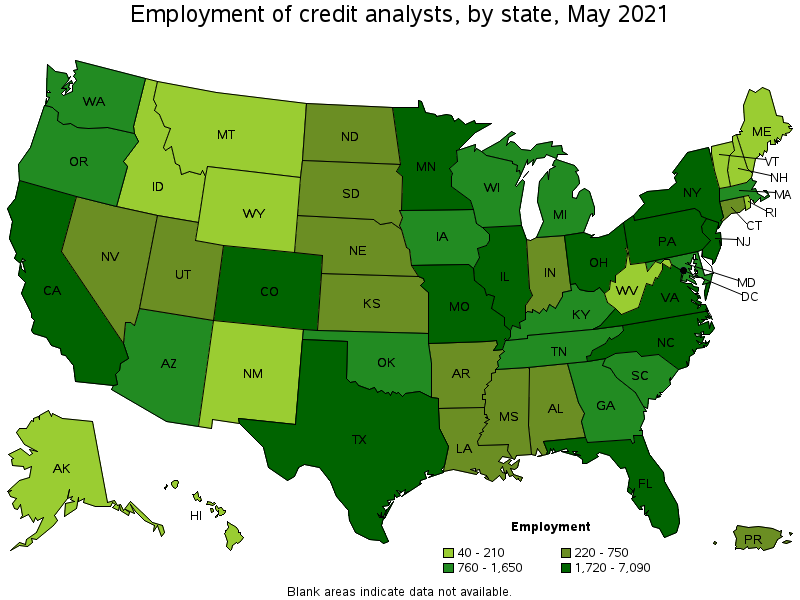
States with the highest employment level in Credit Analysts:
| State | Employment (1) | Employment per thousand jobs | Location quotient (9) | Hourly mean wage | Annual mean wage (2) |
|---|---|---|---|---|---|
| California | 7,090 | 0.43 | 0.88 | $ 44.25 | $ 92,050 |
| New York | 6,810 | 0.79 | 1.61 | $ 62.24 | $ 129,460 |
| Texas | 5,630 | 0.46 | 0.94 | $ 38.95 | $ 81,010 |
| Florida | 3,780 | 0.44 | 0.90 | $ 39.83 | $ 82,850 |
| Illinois | 3,370 | 0.60 | 1.23 | $ 41.18 | $ 85,660 |
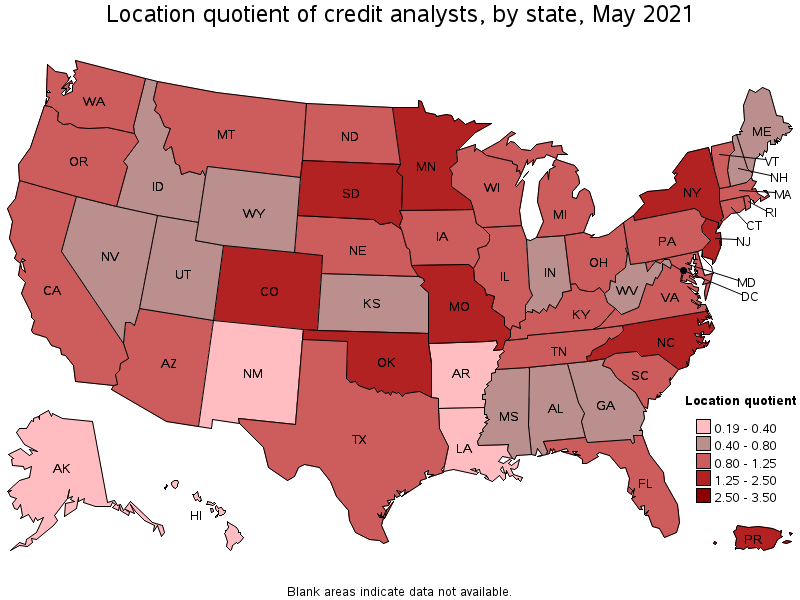
States with the highest concentration of jobs and location quotients in Credit Analysts:
| State | Employment (1) | Employment per thousand jobs | Location quotient (9) | Hourly mean wage | Annual mean wage (2) |
|---|---|---|---|---|---|
| South Dakota | 420 | 0.99 | 2.02 | $ 32.53 | $ 67,670 |
| New York | 6,810 | 0.79 | 1.61 | $ 62.24 | $ 129,460 |
| North Carolina | 3,150 | 0.71 | 1.46 | $ 44.73 | $ 93,040 |
| Missouri | 1,870 | 0.68 | 1.40 | $ 38.37 | $ 79,810 |
| Colorado | 1,720 | 0.66 | 1.34 | $ 43.72 | $ 90,940 |
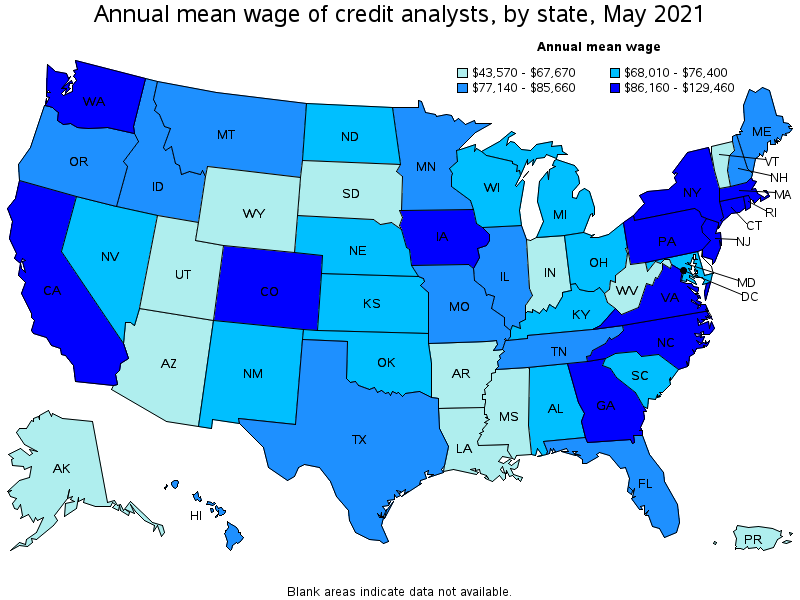
Top paying states for Credit Analysts:
| State | Employment (1) | Employment per thousand jobs | Location quotient (9) | Hourly mean wage | Annual mean wage (2) |
|---|---|---|---|---|---|
| New York | 6,810 | 0.79 | 1.61 | $ 62.24 | $ 129,460 |
| Connecticut | 740 | 0.47 | 0.96 | $ 47.32 | $ 98,430 |
| New Jersey | 2,390 | 0.62 | 1.27 | $ 46.19 | $ 96,080 |
| Virginia | 2,070 | 0.55 | 1.13 | $ 46.15 | $ 95,990 |
| Iowa | 760 | 0.51 | 1.05 | $ 44.90 | $ 93,390 |
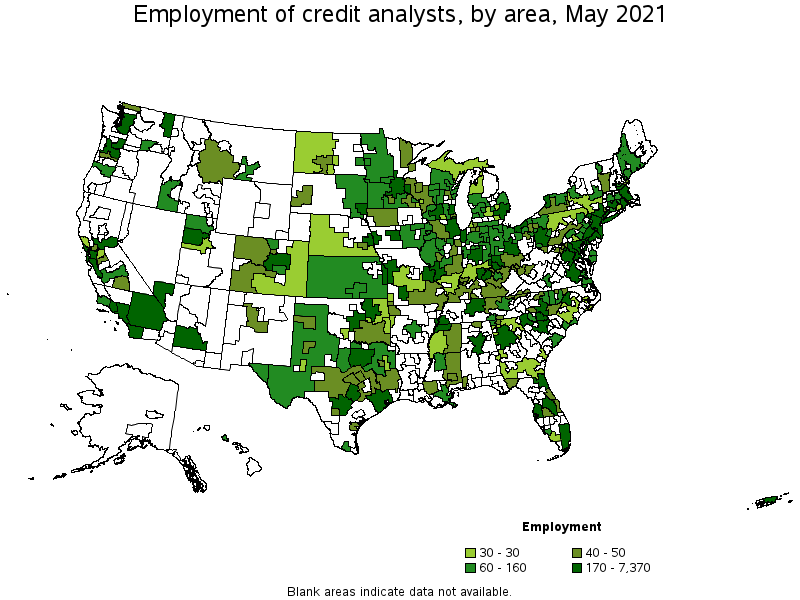
Metropolitan areas with the highest employment level in Credit Analysts:
| Metropolitan area | Employment (1) | Employment per thousand jobs | Location quotient (9) | Hourly mean wage | Annual mean wage (2) |
|---|---|---|---|---|---|
| New York-Newark-Jersey City, NY-NJ-PA | 7,370 | 0.85 | 1.74 | $ 61.99 | $ 128,950 |
| Los Angeles-Long Beach-Anaheim, CA | 3,040 | 0.53 | 1.09 | $ 41.74 | $ 86,820 |
| Dallas-Fort Worth-Arlington, TX | 2,730 | 0.76 | 1.56 | $ 41.81 | $ 86,960 |
| Chicago-Naperville-Elgin, IL-IN-WI | 2,700 | 0.64 | 1.31 | $ 43.09 | $ 89,630 |
| Philadelphia-Camden-Wilmington, PA-NJ-DE-MD | 2,490 | 0.94 | 1.92 | $ 43.07 | $ 89,580 |
| Charlotte-Concord-Gastonia, NC-SC | 2,270 | 1.88 | 3.85 | $ 46.32 | $ 96,350 |
| Phoenix-Mesa-Scottsdale, AZ | 1,420 | 0.67 | 1.37 | $ 32.02 | $ 66,600 |
| San Francisco-Oakland-Hayward, CA | 1,330 | 0.59 | 1.22 | $ 56.67 | $ 117,860 |
| Denver-Aurora-Lakewood, CO | 1,320 | 0.90 | 1.84 | $ 46.31 | $ 96,320 |
| Minneapolis-St. Paul-Bloomington, MN-WI | 1,240 | 0.68 | 1.39 | $ 44.20 | $ 91,940 |
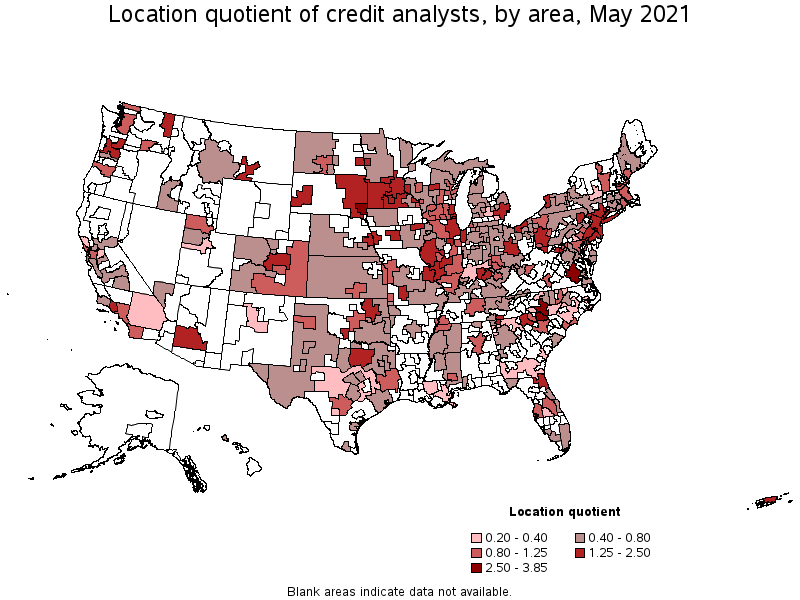
Metropolitan areas with the highest concentration of jobs and location quotients in Credit Analysts:
| Metropolitan area | Employment (1) | Employment per thousand jobs | Location quotient (9) | Hourly mean wage | Annual mean wage (2) |
|---|---|---|---|---|---|
| Charlotte-Concord-Gastonia, NC-SC | 2,270 | 1.88 | 3.85 | $ 46.32 | $ 96,350 |
| Sioux Falls, SD | 250 | 1.61 | 3.30 | $ 34.09 | $ 70,910 |
| Richmond, VA | 990 | 1.60 | 3.28 | $ 47.11 | $ 97,980 |
| Trenton, NJ | 290 | 1.29 | 2.65 | $ 42.50 | $ 88,400 |
| St. Cloud, MN | 120 | 1.21 | 2.48 | $ 31.00 | $ 64,480 |
| Des Moines-West Des Moines, IA | 400 | 1.12 | 2.29 | $ 50.84 | $ 105,740 |
| Tulsa, OK | 440 | 1.04 | 2.14 | $ 32.09 | $ 66,760 |
| Jacksonville, FL | 690 | 1.01 | 2.07 | $ 40.05 | $ 83,300 |
| Spokane-Spokane Valley, WA | 230 | 0.99 | 2.02 | $ 37.11 | $ 77,200 |
| Cleveland, TN | 40 | 0.95 | 1.95 | (8) | (8) |
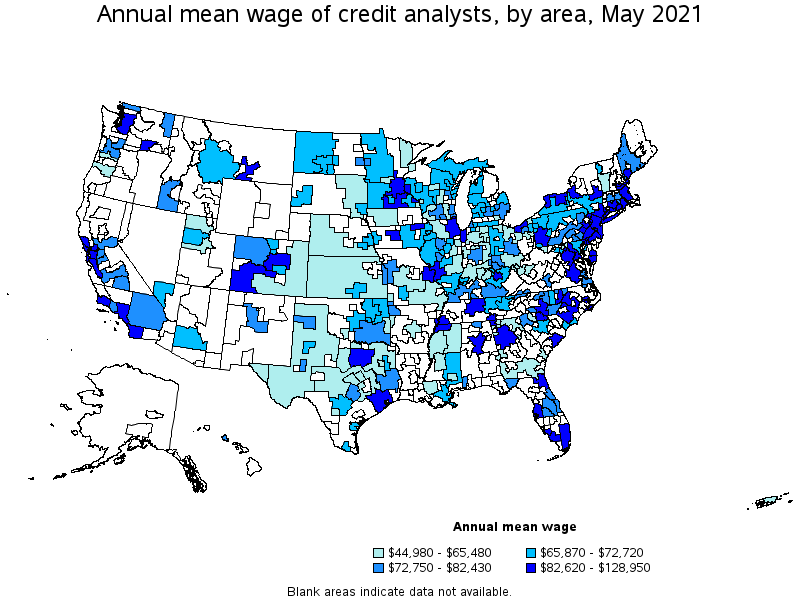
Top paying metropolitan areas for Credit Analysts:
| Metropolitan area | Employment (1) | Employment per thousand jobs | Location quotient (9) | Hourly mean wage | Annual mean wage (2) |
|---|---|---|---|---|---|
| New York-Newark-Jersey City, NY-NJ-PA | 7,370 | 0.85 | 1.74 | $ 61.99 | $ 128,950 |
| Danbury, CT | 50 | 0.67 | 1.37 | $ 58.44 | $ 121,560 |
| San Francisco-Oakland-Hayward, CA | 1,330 | 0.59 | 1.22 | $ 56.67 | $ 117,860 |
| Bridgeport-Stamford-Norwalk, CT | 310 | 0.81 | 1.67 | $ 52.58 | $ 109,360 |
| Des Moines-West Des Moines, IA | 400 | 1.12 | 2.29 | $ 50.84 | $ 105,740 |
| Cedar Rapids, IA | 110 | 0.81 | 1.66 | $ 49.05 | $ 102,020 |
| Atlanta-Sandy Springs-Roswell, GA | 890 | 0.34 | 0.71 | $ 47.14 | $ 98,040 |
| Durham-Chapel Hill, NC | 140 | 0.43 | 0.89 | $ 47.11 | $ 97,980 |
| Richmond, VA | 990 | 1.60 | 3.28 | $ 47.11 | $ 97,980 |
| Charlotte-Concord-Gastonia, NC-SC | 2,270 | 1.88 | 3.85 | $ 46.32 | $ 96,350 |
Nonmetropolitan areas with the highest employment in Credit Analysts:
| Nonmetropolitan area | Employment (1) | Employment per thousand jobs | Location quotient (9) | Hourly mean wage | Annual mean wage (2) |
|---|---|---|---|---|---|
| West Central Illinois nonmetropolitan area | 120 | 0.75 | 1.54 | $ 32.82 | $ 68,260 |
| North Northeastern Ohio nonmetropolitan area (noncontiguous) | 110 | 0.35 | 0.72 | $ 31.23 | $ 64,960 |
| Southeast Minnesota nonmetropolitan area | 100 | 0.64 | 1.31 | $ 40.09 | $ 83,380 |
| North Texas Region of Texas nonmetropolitan area | 90 | 0.34 | 0.70 | $ 29.22 | $ 60,770 |
| Southwest Minnesota nonmetropolitan area | 90 | 0.76 | 1.55 | $ 34.28 | $ 71,300 |
Nonmetropolitan areas with the highest concentration of jobs and location quotients in Credit Analysts:
| Nonmetropolitan area | Employment (1) | Employment per thousand jobs | Location quotient (9) | Hourly mean wage | Annual mean wage (2) |
|---|---|---|---|---|---|
| Southwest Minnesota nonmetropolitan area | 90 | 0.76 | 1.55 | $ 34.28 | $ 71,300 |
| West Central Illinois nonmetropolitan area | 120 | 0.75 | 1.54 | $ 32.82 | $ 68,260 |
| East South Dakota nonmetropolitan area | 80 | 0.67 | 1.37 | $ 29.50 | $ 61,370 |
| Southeast Minnesota nonmetropolitan area | 100 | 0.64 | 1.31 | $ 40.09 | $ 83,380 |
| Western Pennsylvania nonmetropolitan area | 70 | 0.49 | 1.00 | $ 31.67 | $ 65,870 |
Top paying nonmetropolitan areas for Credit Analysts:
| Nonmetropolitan area | Employment (1) | Employment per thousand jobs | Location quotient (9) | Hourly mean wage | Annual mean wage (2) |
|---|---|---|---|---|---|
| Southeast Coastal North Carolina nonmetropolitan area | 30 | 0.14 | 0.29 | $ 44.19 | $ 91,920 |
| Southwest Colorado nonmetropolitan area | 40 | 0.36 | 0.74 | $ 41.48 | $ 86,290 |
| Southeast Minnesota nonmetropolitan area | 100 | 0.64 | 1.31 | $ 40.09 | $ 83,380 |
| Southern Pennsylvania nonmetropolitan area | 40 | 0.23 | 0.47 | $ 39.42 | $ 81,990 |
| Northwest Colorado nonmetropolitan area | 40 | 0.34 | 0.69 | $ 39.32 | $ 81,790 |
These estimates are calculated with data collected from employers in all industry sectors, all metropolitan and nonmetropolitan areas, and all states and the District of Columbia. The top employment and wage figures are provided above. The complete list is available in the downloadable XLS files.
The percentile wage estimate is the value of a wage below which a certain percent of workers fall. The median wage is the 50th percentile wage estimate—50 percent of workers earn less than the median and 50 percent of workers earn more than the median. More about percentile wages.
(1) Estimates for detailed occupations do not sum to the totals because the totals include occupations not shown separately. Estimates do not include self-employed workers.
(2) Annual wages have been calculated by multiplying the hourly mean wage by a "year-round, full-time" hours figure of 2,080 hours; for those occupations where there is not an hourly wage published, the annual wage has been directly calculated from the reported survey data.
(3) The relative standard error (RSE) is a measure of the reliability of a survey statistic. The smaller the relative standard error, the more precise the estimate.
(8) Estimate not released.
(9) The location quotient is the ratio of the area concentration of occupational employment to the national average concentration. A location quotient greater than one indicates the occupation has a higher share of employment than average, and a location quotient less than one indicates the occupation is less prevalent in the area than average.
Other OEWS estimates and related information:
May 2021 National Occupational Employment and Wage Estimates
May 2021 State Occupational Employment and Wage Estimates
May 2021 Metropolitan and Nonmetropolitan Area Occupational Employment and Wage Estimates
May 2021 National Industry-Specific Occupational Employment and Wage Estimates
Last Modified Date: March 31, 2022